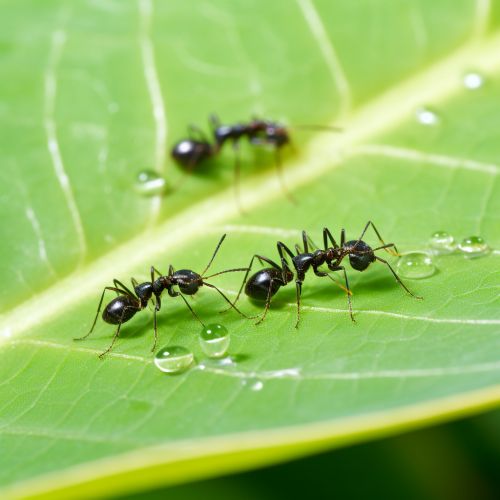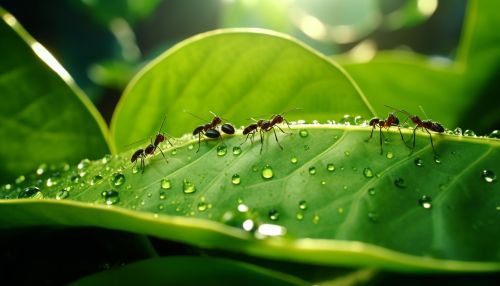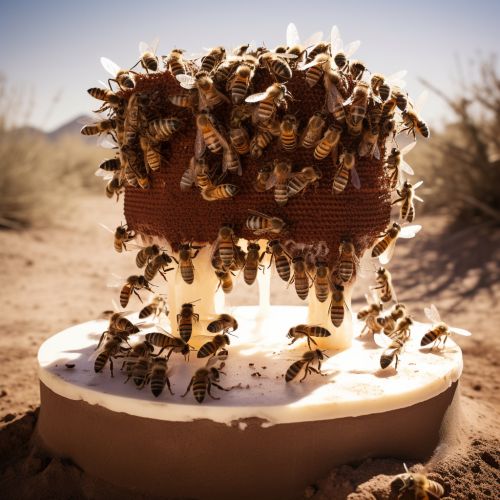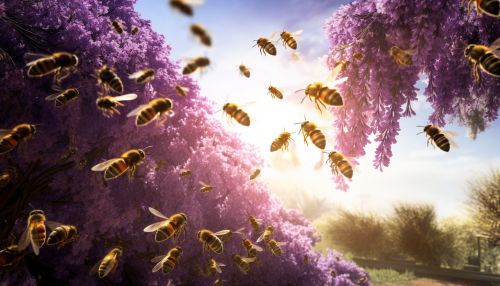Chemical Communication in Insect Societies
Introduction
Chemical communication in insect societies is a complex and intricate process that involves the use of chemical signals, or pheromones, to convey information. This form of communication is integral to the survival and success of many insect societies, including ants, bees, and termites. It is used for a variety of purposes, such as foraging, defense, reproduction, and colony recognition.


Pheromones and their Role in Insect Societies
Pheromones are chemical substances produced by an insect that can affect the behavior or physiological processes of other members of the same species. They are typically secreted from specialized glands and are detected by the insect's antennae, which are equipped with olfactory receptors. Pheromones play a crucial role in the organization and functioning of insect societies, and their effects can be both immediate and long-lasting.
Types of Pheromones
There are several types of pheromones used by insects, each serving a different purpose. These include:
- Alarm pheromones: These are released when an insect is threatened or injured, alerting other members of the colony to the presence of danger.
- Trail pheromones: These are laid down by foraging insects to mark a path to a food source. Other members of the colony can follow this trail to find food.
- Sex pheromones: These are used to attract mates. They are typically produced by females and detected by males.
- Queen pheromones: These are produced by the queen of a colony to regulate the reproductive behavior of other members.
- Recognition pheromones: These are used to identify members of the same colony. They help to prevent conflicts and promote cooperation among colony members.
Chemical Communication in Ants
Ants are one of the most well-studied groups of insects when it comes to chemical communication. They use a variety of pheromones to coordinate their activities and maintain the complex social structure of their colonies.
Foraging and Trail Pheromones
When a foraging ant finds a food source, it will lay down a trail of pheromones on its way back to the colony. This trail serves as a guide for other ants to find the food source. The more ants that follow the trail and find food, the stronger the trail becomes, as each ant adds more pheromones to it. This form of positive feedback helps the colony quickly exploit a food source.
Alarm Pheromones
When an ant is threatened or injured, it releases alarm pheromones. These chemicals alert other ants to the presence of danger and can trigger aggressive behavior. The specific response to alarm pheromones can vary depending on the species of ant and the nature of the threat.
Queen and Recognition Pheromones
The queen ant produces pheromones that regulate the behavior and development of other ants in the colony. These queen pheromones can suppress the reproductive capabilities of worker ants, ensuring that the queen is the only ant producing offspring. Recognition pheromones, on the other hand, are used to identify members of the same colony. They are crucial for maintaining social cohesion and preventing conflicts within the colony.


Chemical Communication in Bees
Like ants, bees also rely heavily on chemical communication to coordinate their activities and maintain the social structure of their colonies. However, the specific ways in which bees use pheromones can be quite different from ants.
Foraging and Recruitment Pheromones
When a foraging bee finds a rich source of nectar or pollen, it will return to the hive and perform a waggle dance to communicate the location of the food source to other bees. However, this dance is not the only way bees communicate about food. They also use pheromones to recruit other bees to help collect the food. These recruitment pheromones can be found in the nectar or pollen itself, or they can be produced by the foraging bee.
Queen and Brood Pheromones
The queen bee produces a variety of pheromones that regulate the behavior and development of the worker bees in the colony. These queen pheromones can suppress the reproductive capabilities of worker bees, promote worker bee foraging, and even influence the development of larvae. In addition to queen pheromones, brood pheromones are also important for the functioning of a bee colony. These pheromones are produced by the larvae and influence the behavior of adult bees, such as stimulating them to feed the larvae.
Alarm Pheromones
Bees also use alarm pheromones to alert other members of the colony to the presence of danger. When a bee stings an intruder, it releases alarm pheromones that attract other bees to the location and stimulate them to attack. This coordinated defensive response helps to protect the colony from threats.
Chemical Communication in Termites
Termites, like ants and bees, use chemical communication to coordinate their activities and maintain the social structure of their colonies. However, the ways in which termites use pheromones can be quite unique.
Trail and Recruitment Pheromones
Termites use trail pheromones to mark paths to food sources, much like ants. However, termites also use these pheromones to recruit other termites to help with tasks such as building or repairing the nest. This recruitment behavior is crucial for the functioning of the termite colony, as it allows for efficient division of labor.
Queen and Recognition Pheromones
The queen termite produces pheromones that regulate the behavior and development of other termites in the colony. These queen pheromones can suppress the reproductive capabilities of worker termites, ensuring that the queen is the only termite producing offspring. Recognition pheromones, on the other hand, are used to identify members of the same colony. They are crucial for maintaining social cohesion and preventing conflicts within the colony.
Alarm Pheromones
When a termite is threatened or injured, it releases alarm pheromones. These chemicals alert other termites to the presence of danger and can trigger defensive behavior. The specific response to alarm pheromones can vary depending on the species of termite and the nature of the threat.
Conclusion
Chemical communication is a fundamental aspect of insect societies. It allows for efficient coordination of activities, maintenance of social structure, and response to threats. The study of chemical communication in insects provides valuable insights into the complex social behaviors of these creatures and can also have practical applications, such as in the development of more effective pest control strategies.
